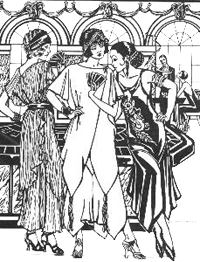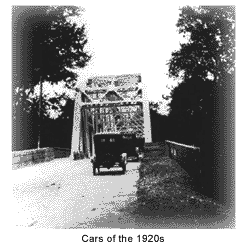The 1920s era went by such names as the Jazz Age, the Age of Intolerance, and the Age of Wonderful Nonsense. Under any moniker, the era embodied the beginning of modern America. Numerous Americans felt buoyed up following World War I (1914-1918). America had survived a deadly worldwide Influenza epidemic (1918). The new decade of the roaring twenties would be a time of change for everyone — not all of it good.
Presidential Administrations
The close of World War I saw the United States recede into an inward-looking stance. In spite of President Woodrow Wilson`s unflagging efforts, the Senate refused to ratify the Versailles Peace Treaty that ended World War I, and the U.S. failed to join the League of Nations. Early in the 1920s the U.S. raised tariffs on imported goods, and free immigration came to an end.
Elected president in 1920, Warren G. Harding promoted a "return to normalcy," which signaled a resurgence of nativism, Isolationism, and rejection of the progressive era`s governmental activism. Overall, Harding`s policies reflected a conservative, laissez-faire attitude. His administration was blighted by scandals, but most of them did not surface until following his death of a stroke in office in August 1923. One of the most notorious of them was the Teapot Dome Scandal, which appalled the public for years after Harding`s death.
Calvin Coolidge was Harding`s vice president (1921-23). When the presidency fell to his lot with Harding`s death, he moved swiftly to sew up the 1924 nomination and mend the effects of the administration`s scandals. Coolidge was elected handily over Democrat John W. Davis and Progressive Robert M. La Follette. He declined to run for reelection in 1929 and left politics for good. Such Coolidge administration policies as high tariffs and federal tax cuts were generally approved of during his four years, but they would become unpopular during the next decade.
Having served as secretary of commerce under both Harding and Coolidge, Herbert Hoover was elected to the presidency in 1928, buoyed by the country`s prosperity. His personal popularity suffered, however, when he vetoed the Veterans`s Bonus proposal. Hoover had been in office just a few months when the Great Depression began to carve its trough into the nation`s economy. His early relief efforts were generally viewed to be inadequate. A banking crisis had seized the nation and in 1932, he lost the presidential election to Franklin D. Roosevelt.
Social Ferment
The so-called Red Scares during the roaring twenties refer to the fear of Communism in the U.S. just before and during the 1920s. It is estimated that there were 150,000 anarchists or Communists in the U.S. in 1920, but they constituted only 0.1 percent of the general population. The highly publicized Sacco and Vanzetti Case exemplified what could happen to people who held radical views.
Historians often point out that Americans had withdrawn into a provincialism as evidenced by the reappearance of the Ku Klux Klan, restrictive immigration laws, and Prohibition.
Amendment 18 to the Constitution (1919) had prohibited the manufacture, transport and sale of intoxicating liquor. Prohibitionists anticipated that Prohibition would alleviate social problems and bolster the economy. However, many people disliked the law and imbibed in unlawful nightclubs called speakeasies. Gangsters took control of bootlegging (illegal distribution of liquor) and violent lawlessness erupted. Lacking public support, the federal government was virtually unable to enforce Prohibition.
 Youthful "Flapper" women provoked older people with brief skirts, bobbed hair, and cavalier use of makeup and cigarettes.
Youthful "Flapper" women provoked older people with brief skirts, bobbed hair, and cavalier use of makeup and cigarettes.
Crazes included such dances as the Charleston, dance marathons, flagpole sitting and flying stunts. Baseball`s Babe Ruth and other sports figures became heroes.
Arts and Ideas
The roaring twenties ushered in a rich period of American writing, distinguished by the works of such authors as Sinclair Lewis, Willa Cather, William Faulkner, F. Scott Fitzgerald, Carl Sandburg and Ernest Hemingway.
A uniquely American music form, whose roots lay in African expression, came to be known as jazz. The Jazz Age produced such greats as Louis Armstrong, Duke Ellington and Fletcher Henderson. George Gershwin, Cole Porter and others would bring jazz influences to Broadway and the concert hall. Bessie Smith hallowed the Blues on a sound recording.
Charlie Chaplin and Rudolph Valentino were tremendous movie box office draws. Walt Disney would produce his first cartoon, Alice`s Wonderland.
The lush, ornate style of Art Deco architecture, art, clothing, hairstyles, decor and furnishings flourished in the 1920s.
In 1925, the "Scopes Monkey Trial," a celebrated case, altered the public`s view of Charles Darwin`s theory of evolution forever. The trial also was the first ever to be broadcast live on radio.
In the Billy Mitchell Court-Martial (December 1925), General Mitchell`s widely publicized gambit emphasized the role of air power in the American military establishment.
Will Durant`s The Story of Philosophy would sell millions of copies.
The Economy, Technology and Science
At the beginning of the roaring twenties, the United States was converting from a wartime to peacetime economy. When weapons for World War I were no longer needed, there was a temporary stall in the economy. After a few years, the country prospered. In this decade, America became the richest nation on Earth and a culture of consumerism was born.
It was the time of the $5 workday, good worker pay for those days. People spent money for better roads, tourism, and holiday resorts. Real estate booms, most notably in Florida, sent land prices soaring.
Invention
Technology played a vital part in delivering the economic and cultural good times that most of America enjoyed during the 1920s.
 Henry Ford blazed the way with his Model T; he sold more 15 million of them by 1927. Ford`s assembly line means of production was the key. The automobile`s popularity, and construction of roads and highways — pouring fresh public funds into the economy — brought tremendous economic prosperity during the roaring twenties.
Henry Ford blazed the way with his Model T; he sold more 15 million of them by 1927. Ford`s assembly line means of production was the key. The automobile`s popularity, and construction of roads and highways — pouring fresh public funds into the economy — brought tremendous economic prosperity during the roaring twenties.
The radio found its way into virtually every home in America. Following the first public station, KDKA, in Pittsburgh, thousands more went on the air across the country. Radio became a national pastime; many listeners would gather in their living rooms to tune in sports, concerts, sermons, and "Red Menace" news.
The year 1922 introduced the first movie made with sound, The Jazz Singer, starring Al Jolson. And in 1926, the advent of Technicolor made movies more entertaining and memorable. Consequently, the movie industry became a major part of American industry in general.
Charles A. Lindbergh`s pioneering flight across the Atlantic Ocean in the Spirit of St. Louis in 1927 did much to stimulate the young aviation industry.
Canned foods, ready-made clothing and household appliances liberated women from much household drudgery. The influence of Ford`s methods of mass production and efficiency enabled other industries to produce a huge variety of consumer appliances.
However, not everyone benefited from technology.
The number of people living and working on farms reached its peak at 32,530,000 back in 1916. The majority of the farms were relatively small operations. New technology in the roaring twenties introduced a number of impacts on the American farm:
The year 1920 was a historic watershed. For the first time in the United States, more people were living in cities than on farms.
Science and Public Health
Science, medicine and health advanced remarkably during the roaring twenties. Albert Einstein was awarded the Nobel Prize in physics in 1921. Diphtheria became better controlled in 1923 by newly introduced immunization. An interest developed in nutrition, caloric consumption and physical vitality. With the Flapper`s focus on dieting and her popular look came a significant change in the dietary habits of Americans as a whole — less fat and meat, and more fruits and vegetables. The discovery of vitamins and their effects also occurred around the same time.
Countervailing tendencies lay in cigarette consumption, which rose to roughly 43 billion annually, and bootleg liquor became a $3.5 billion-a-year business during the same period.
The Stock Market
It seemed as though Dow Jones Industrial Stock Index would never quit increasing. Stock speculation went sky high in the bull market of 1928-1929. No one suspected that a signal of the end would occur on October 24, 1929, with the infamous stock market crash, and that more than a decade of Depression and despair would follow such an era of happiness and prosperity.
Until that time, American life seemed fundamentally sound. The typical American was still hardworking and sensible. The coming storms lay unseen beyond the horizon as the twenties roared on. Writing in 1931, F. Scott Fitzgerald^ wrote in Echoes of the Jazz Age:
It ended two years ago, because the utter confidence which was its essential prop received an enormous jolt, and it didn`t take long for the flimsy structure to settle earthward. And after two years the Jazz Age seems as far away as the days before the War. It was borrowed time anyhow — the whole upper tenth of a nation living with the insouciance of grand ducs and the casualness of chorus girls. But moralizing is easy now and it was pleasant to be in one`s twenties in such a certain and unworried time.